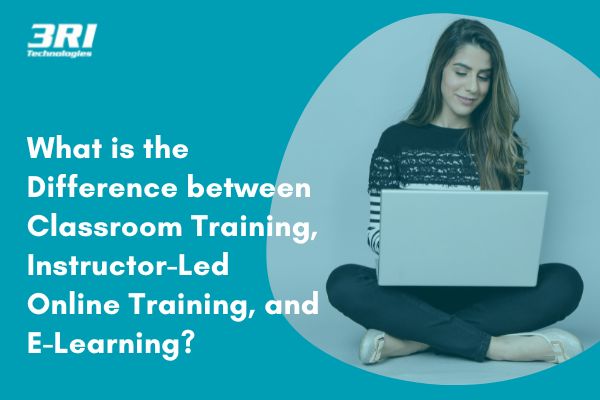Organizations that provide education and customer training aim to provide their clients with training that is simple to understand and accessible. For training firms, the correct customer training offers can be a reliable source of income, but there are several different strategies to consider. The 3RI technologies are:-
Choosing between classroom training, instructor-led training, and virtual instructor-led training can shape your career success. But what is instructor-led training, and how does it compare to other formats? Whether you’re aiming to boost your career or increase your ML engineer salary in India, selecting the right mode of machine learning training is crucial. At 3RI Technologies, our job-orientated courses are designed to meet diverse learning preferences while ensuring practical skills and placement support. This guide compares all training types to help you choose a method that aligns with your career goals and learning style.
Which Training Format is Best for Your Career Growth?What is Classroom Training?
As the name suggests, classroom learning includes the advantages of a single traditional classroom. To be an active learner and participate in class, there must be a particular number of participants or pupils. The teachers and the students must be present in person in the classroom. Open discussion and direct connection between students and professors are encouraged in the school. Through group projects, peer review, and group discussions, classroom learning fosters interaction between the instructors and the students. Customer-accessible virtual classroom training is the instruction given in a real classroom setting. Individuals register to attend on the desired date in the preferred location after the class schedules and locations are released on a website. Despite popular belief, a recent TSIA Education Services Quick Poll demonstrates no decline in classroom instruction. 50% of survey respondents claimed to have taught more lessons in 2019 compared to 2018. The 60 percent classroom fill rate is also the same across the two years. With public classroom training accounting for 25% of all customer training revenue, it is still a very viable source of income for educational organizations.
Advantages of classroom training
- It enables you to train workers in a secure, peaceful, and orderly setting, away from the commotion and stress of the workplace.
- Various sizes of training groups are possible.
- The crucial “human touch,” frequently lacking in technology-based training, is provided by the classroom setting.
- Learning is enriched by group interaction. Both the trainer and the employees teach each other new things.
- Another skill frequently lacking from other training methods is how to engage with one another in a professional, beneficial, and cooperative way.
Disadvantages of classroom training
- Employees must be removed from the workplace, which interferes with work hours and production schedules.
- This type of training might be challenging to schedule when you work shifts, especially for nightshift employees.
- Although the classroom setting is calm, secure, and supportive of concentrated learning, it is also isolated from the tools, procedures, and supplies those workers use on the job. Adult learning is frequently hampered by a lack of practical experience.
What is instructor-led online training?
Instructor-Led Online Training is remotely delivered using lab work and web conferencing infrastructure tools. Virtual instructor-led training is categorized as virtual instructor-led training even though it uses a “live” instructor and is provided electronically, as opposed to e-learning, which uses asynchronous delivery methods. Like open classroom training, VILT class schedules are posted online, where anybody around the globe can register to participate. There is no need to submit location information because the training is done remotely. Surprisingly, over the ten years that TSIA has performed the Education Services Benchmark Survey, the revenue growth from VILT has not varied significantly. When the benchmark was originally conducted in 2010, VILT accounted for 11% of ES income; today, that number is 15%. However, there is a caveat to that, which is that VILT is frequently bundled with a learning subscription. I’ll expand on that later in the section on online learning.
Advantages of instructor-led online training
- Real-Time Questions and Comments: One of the main benefits of instructor-led training is the chance for instructors to reply in real-time to feedback and to questions that arise throughout the training. Any queries or concerns can be addressed in the middle of the course with a genuine, live instructor, whether they are present in person or online.
- Flexibility: Since instructor-led online courses are live instructors, the session can be changed as it progresses to fit the requirements and inquiries of the class and provide the most proper, thorough instruction possible.
- Experiential Benefits: Using interactive approaches for instructor-led training is another fantastic benefit since instructors can switch between huge conversations and breakout rooms, and role-playing scenarios to engage everyone.
Disadvantages of instructor-led online training
- Cost: The average cost of instructor-led instruction is expensive, both in terms of time and money.
- Consistency: Inconsistent Training may result from teachers using diverse teaching methods.
- Time Commitment: Unlike learning, in-person or live virtual training necessitates a time commitment from learners, asking them to plan time away from work or other obligations.
- Initial Skill Level: With ILT, everyone in the class receives the same instruction and begins at the same point; but, because different students have varying skill levels, the speed of the class may not be suitable for all trainees.
What is e-learning?
Training that is offered electronically is known as e-learning, sometimes known as online, digital, or on-demand training. E-learning can be performed online and can take the form of a section of the text, a module, a chapter, a course, or a programmer. Most online courses have a virtual lab where students can do practical tasks. Quizzes and evaluations are also commonplace in e-learning; job-oriented courses are social components, including chats, forums, blogs, and badges. The beauty of e-learning is that it allows students to consume content in bite-sized chunks, similar to a performance support model (training when they need it), or they can adopt a more systematic approach, following a learning path, to finish a full course and possibly obtain a certification along the way. As seen in the graph below, the share of the revenue from subscription offers is rising. I already alluded to the complexity of the money generated by online instructor-led training. The 15% previously mentioned applied only to the sale of VILT as a standalone item. VILT is one of the components that most learning subscriptions share. The 28 percent of education revenue that is related to subscription offerings, then, includes part of the income that VILT would have received in the past had there not been a learning subscription.
Advantages of e-learning
- Customized Pace: With eLearning, students can go at their rate and complete the session at a pace that is suitable for them, ensuring that they fully comprehend and assimilate the material.
- Convenience: eLearning choices are significantly more complex than their ILT counterparts because employees can complete them from the comfort of their homes and on time without having to travel to a classroom or show up to a virtual class at a specified time.
- Saving time and money: eLearning training provides all employees with access to a single pre-made course, saving money on instructors and preventing employees from taking time off from work.
Disadvantages of e-learning
- Bothersome Elements: Although e-Learning is designed to be interesting, occasionally, the staff may find the numerous multimedia components to be obsolete or distracting.
- Continuous Revisions: To keep learning relevant, current, and correct, e-Learning must undergo periodic revisions in response to changes in the field and new systems.
- No Ability to Adjust to Feedback or Questions: Unlike a live instructor, an eLearning programmer cannot be adjusted to student feedback or questions because it concentrates on the fundamentals and is pre-made for everyone.




